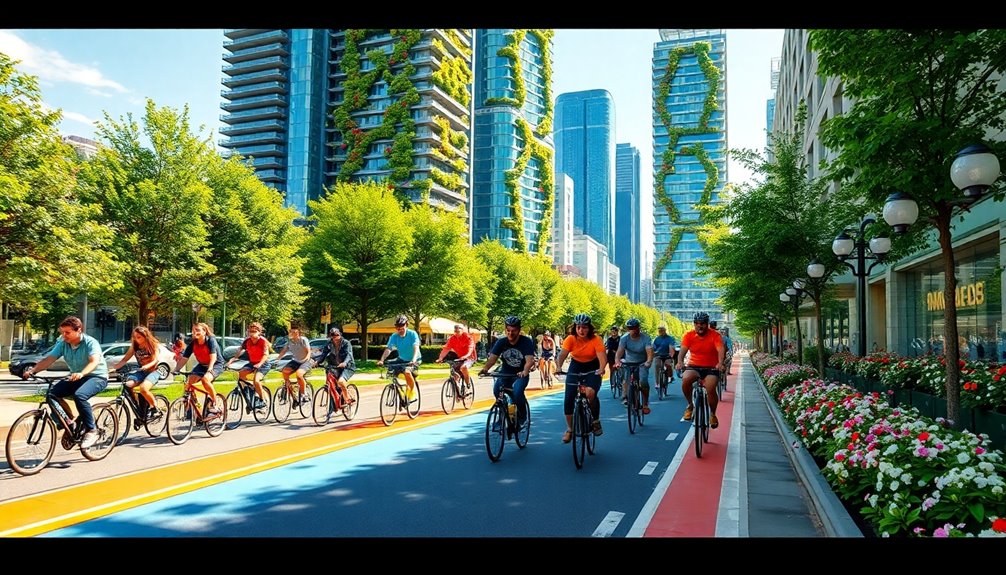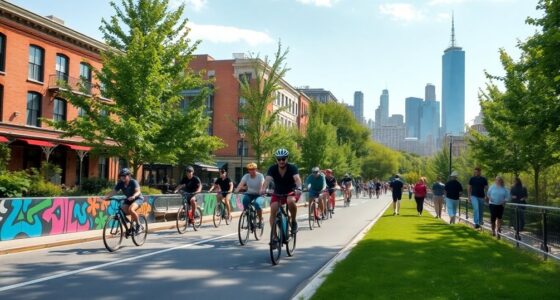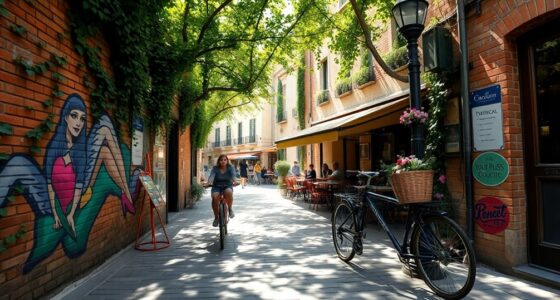Urban cycling makes your city greener by reducing air pollution and lowering carbon emissions. It conserves energy since bikes don't use fossil fuels, and creates quieter streets. Additionally, bike-friendly infrastructure boosts local economies and enhances property values. Cycling promotes better health by encouraging physical activity, while also fostering community interaction and inclusivity. You'll find that cities with strong cycling cultures enjoy a better quality of life, and there's so much more to discover about the benefits of urban cycling.
Key Takeaways
- Cycling reduces air pollution by minimizing harmful gases like CO2 and nitrogen dioxide, contributing to cleaner urban air quality.
- Bicycles conserve energy by not relying on fossil fuels, supporting sustainable urban transportation.
- The presence of cycling infrastructure lowers traffic congestion, enhancing overall urban efficiency and productivity.
- Cycling promotes community well-being by encouraging outdoor activity, reducing health risks, and fostering social interactions.
- Protected bike lanes create safer environments, reducing injuries and enhancing accessibility for all urban cyclists.
Environmental Benefits of Cycling

When you choose to cycle instead of driving, you're not just making a healthier choice for yourself; you're also significantly reducing air pollution.
Choosing to cycle over driving benefits both your health and the environment by significantly cutting down air pollution.
By opting for a bike, you minimize the harmful gases released by motor vehicles, like CO2 and nitrogen dioxide. This not only conserves energy—since bicycles don't consume fossil fuels—but also helps preserve green spaces and biodiversity.
Plus, cycling generates less noise, contributing to a quieter environment. Each ride you take supports sustainable transportation, encouraging a shift away from fossil fuel dependence.
Your decision to cycle helps lower your carbon footprint, mitigating climate change effects and improving air quality.
Ultimately, cycling promotes a cleaner, greener city for everyone, enhancing both your health and the environment.
Economic Advantages of Cycling Infrastructure
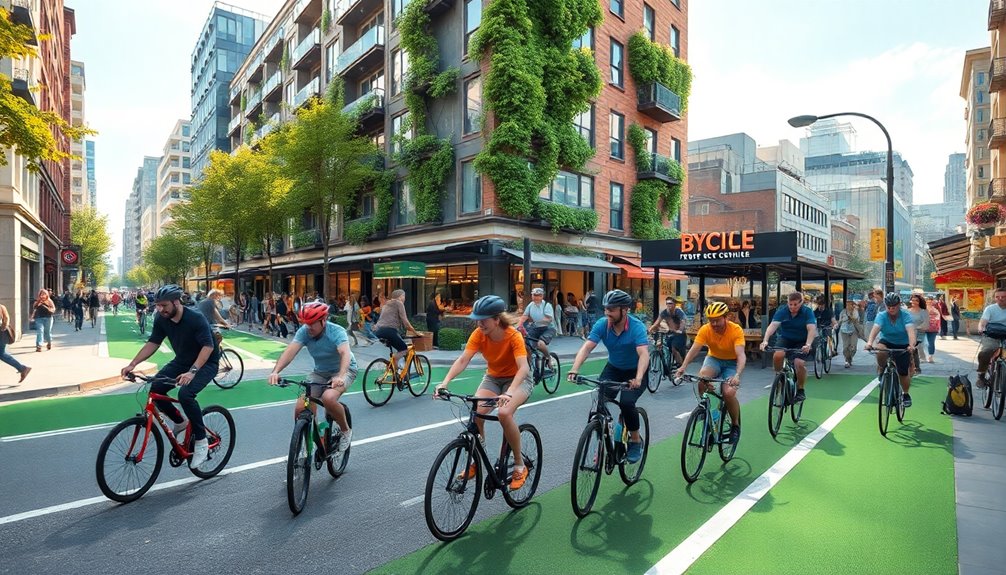
Cycling not only benefits the environment but also presents significant economic opportunities for cities. Investing in cycling infrastructure creates more jobs per dollar compared to traditional road projects, making it a smart financial choice.
These projects are also cost-effective, enhancing communities without breaking the bank. Cycling tourism can boost local economies, as visitors spend on food, lodging, and services.
Plus, reduced traffic congestion saves cities money on lost productivity. Bike-friendly areas attract foot traffic, benefitting local businesses and increasing property values.
With lower parking costs and scalable infrastructure, cycling investment yields long-term economic returns, supporting diverse activities and increasing tax revenue. Furthermore, promoting regular physical activity through cycling contributes to overall community wellness, which in turn enhances productivity.
In short, cycling infrastructure is a win-win for both the economy and the community.
Health and Well-Being From Regular Cycling
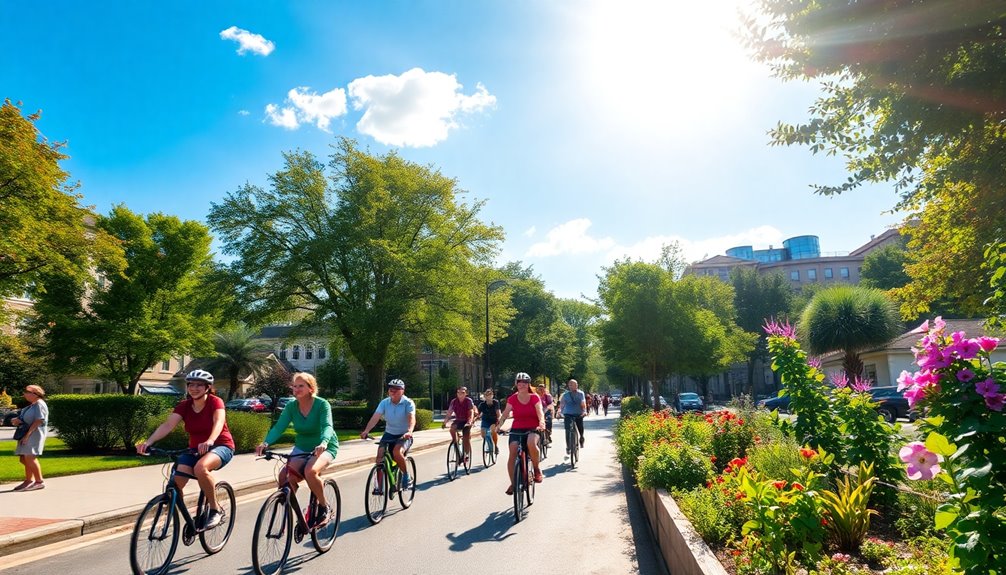
Embrace the power of regular cycling to transform your health and well-being. This enjoyable activity significantly boosts your cardiovascular health, reducing heart disease risk by 46% and lowering cardiovascular-related deaths by 52%.
Plus, it's linked to a 45% lower cancer risk. You'll also find that cycling can uplift your mental health, decreasing depression risk by 19% and potentially increasing your life expectancy by about 3.4 years.
As you pedal, you'll burn up to 300 calories per hour, making it easier to manage your weight and maintain muscle strength.
Overall, cycling not only enhances your physical fitness but also leads to improved mood and reduced stress, creating a happier, healthier you.
Safety and Accessibility in Cycling Design

As urban areas grow, ensuring safety and accessibility in cycling design becomes crucial for fostering a vibrant cycling culture.
Protected bike lanes significantly reduce intersection injuries by about 75%, making streets safer for everyone. In New York City, these lanes led to a 56% reduction in injuries for all street users, proving that safe designs work.
Protected bike lanes can decrease intersection injuries by 75%, creating safer streets for all users.
Visibility enhancements like street lighting and reflective bike surfaces further bolster safety.
However, accessibility issues persist, particularly for underserved groups. Prioritizing inclusive policies ensures safe spaces for all cyclists, including women, children, and those with disabilities.
Community and Social Impact of Cycling

When communities invest in cycling infrastructure, they not only enhance transportation options but also foster a sense of belonging and connection among residents.
Cycling brings people together, increasing social interaction among cyclists and with others in the community. Protected bike lanes create inclusive public spaces where everyone feels safe and welcome.
Community events centered around cycling promote unity and shared experiences, strengthening bonds among residents. Additionally, well-connected bike networks improve access to essential services like libraries and healthcare, addressing social equity.
By making cycling accessible, communities can bridge income gaps, enhance job accessibility, and support local economies.
Ultimately, cycling enriches community life and cultivates a healthier, more connected environment for everyone.
Urban Planning and Development for Sustainable Mobility
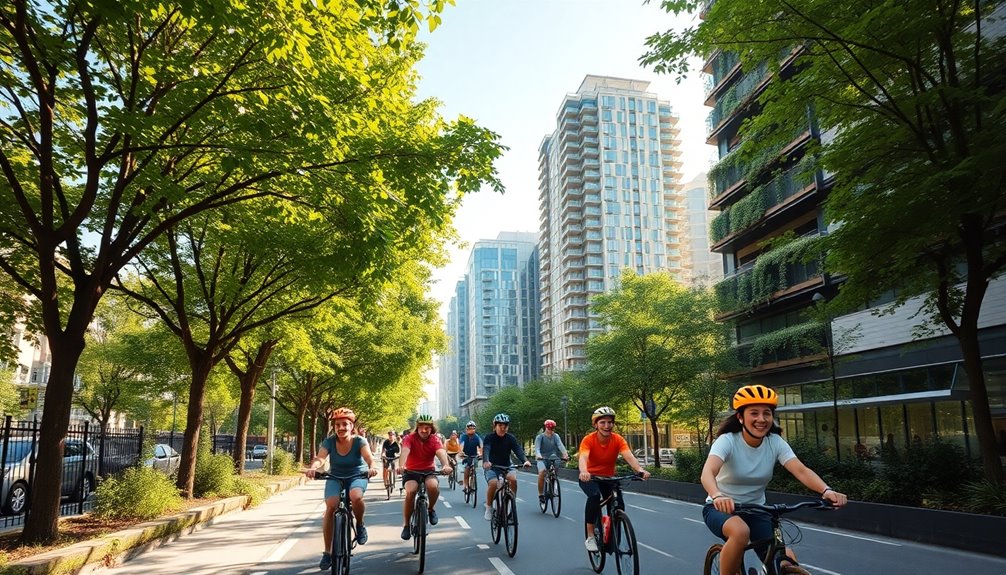
Effective urban planning and development are crucial for creating sustainable mobility options, especially in growing cities. By integrating cycling infrastructure with existing public transport, you enhance your mobility choices.
Mixed-use developments cut down on long commutes, making cycling more viable. Incorporating green spaces adds beauty and promotes environmental sustainability along cycling routes.
Mixed-use developments and green spaces enhance cycling viability, promoting beauty and environmental sustainability in urban landscapes.
Safety measures like dedicated bike lanes and traffic calming are essential to encourage more people to cycle. Involving local residents in the planning process ensures the infrastructure meets community needs.
Monitoring indicators like emissions reduction and modal share helps assess the effectiveness of cycling initiatives. By prioritizing these principles, you can create an accessible, efficient, and sustainable cycling environment that benefits everyone in your city.
Frequently Asked Questions
How Can I Start Cycling in My City Safely?
To start cycling safely in your city, first, get the essential safety gear like a helmet and reflective clothing.
Familiarize yourself with traffic laws and practice using hand signals. Regularly check your bike's condition and plan your routes to avoid heavy traffic.
Utilize dedicated bike lanes whenever possible, and stay alert for pedestrians and other vehicles.
Lastly, adapt to weather conditions to ensure your comfort and safety while riding.
What Gear Do I Need for Urban Cycling?
To start urban cycling safely, you'll need essential gear like a helmet for head protection and lights to improve visibility.
Reflective gear helps others see you, especially at night. Invest in a sturdy lock to secure your bike and carry a multi-tool for minor repairs.
For comfort, consider padded shorts and moisture-wicking jerseys. Don't forget spare tubes and a pump to handle any flat tires during your rides.
Being prepared makes cycling enjoyable!
Are There Any Cycling Clubs or Groups in My Area?
If you're looking for cycling clubs in your area, there are plenty to choose from!
Clubs like the Almaden Cycle Touring Club and the Sunnyvale Cupertino Cycling Club offer various rides for all skill levels.
You might also find groups like Coastside on Bikes and the Fremont Freewheelers emphasizing safety and community.
Joining one can enhance your cycling experience, provide social opportunities, and help you connect with fellow enthusiasts who share your passion.
How Can I Encourage Others to Cycle More?
Encouraging others to cycle more can be like planting seeds in a garden—nurture them, and they'll flourish.
Start by sharing your enthusiasm for cycling; invite friends on rides or organize a local group.
Promote bike-friendly events and highlight the benefits of cycling, such as saving money and staying healthy.
You might even consider starting a bike-sharing program, making it easier for everyone to hop on a bike and join in on the fun!
What Are the Best Routes for Cycling in Urban Areas?
When you're looking for the best routes for cycling in urban areas, consider options like the Grand Rounds Scenic Byway for stunning views or the Midtown Greenway for a safe, dedicated path.
The Mississippi River Trail offers a scenic ride through the city, while the Chain of Lakes provides a relaxing escape.
Don't forget about trails in Theodore Wirth Park for some exciting mountain biking. Each route has its unique charm waiting for you to explore!
Conclusion
In a world where cars choke our cities and smog blankets the skies, embracing urban cycling's the superhero we desperately need! By pedaling through our neighborhoods, you're not just reducing pollution; you're turbocharging the economy, boosting health, and weaving a vibrant tapestry of community connections. Imagine a city where the air sparkles and the streets hum with life—cycling can make that dream a reality! So, hop on your bike and join the revolution for a greener, happier city!
